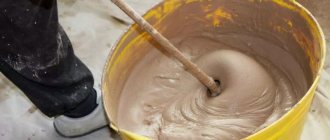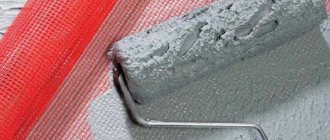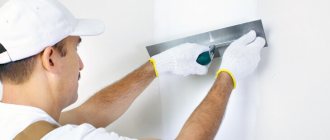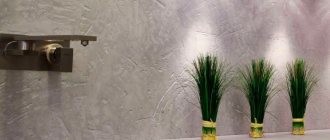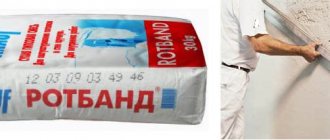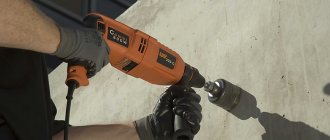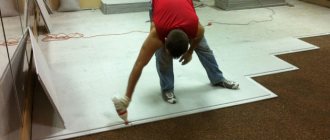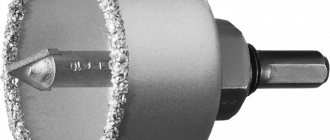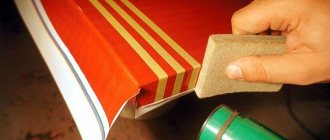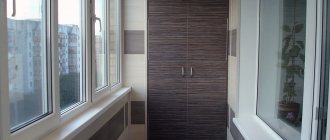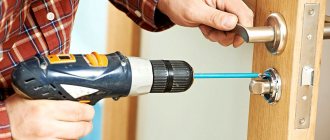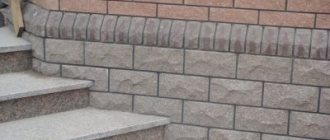About the quality of the plaster coating
An untrained reader may think that the adjectives “simple”, “improved”, “high quality” in relation to plaster determine the quality of the mortar used. However, this is not at all true - we are talking exclusively about the characteristics of the plaster finish, the technology of work and the intended purpose of the coating. Thus, simple plaster can be used to prepare the base for subsequent cladding with tiles or other materials. In other words, in cases where subsequently applied finishing technologies will level out some of the nuances of plastering work.
But in situations where it is necessary to obtain a flat wall plane, plastering is carried out according to an improved option.
As a rule, we are talking about finishing the facades of buildings or the interiors of production facilities. Well, only high-quality plaster should be used inside residential buildings, which has the most stringent requirements for the quality of the resulting coating. These requirements are specified in regulatory documents. For example, in table. 9 SNiP 3.04.01-87, on the basis of which we collected the data presented in the table below. Requirements for simple, improved and high-quality plaster
| Requirements | Simple | Improved | High quality | |
| For surfaces | Max deviation from vertical, mm/m | 3 | 2 | 1 |
| Max deviation to room height, mm/m | 15 | 10 | 5 | |
| Max horizontal deviation, mm/m | 3 | 2 | 1 | |
| Max number of irregularities and their height/depth on an area of 4 m2 | 3 pcs. 5 mm | 2 pcs. 3 mm | 2 pcs. 2 mm | |
| For slopes, pillars, pilasters, husks, etc. | Max deviation from vertical, mm/m | 4 | 2 | 1 |
| Max deviation for the entire element, mm/m | 10 | 5 | 3 | |
| Max deviation of slope width from the design value, mm | 5 | 3 | 2 | |
| For curved surfaces | Max radius deviation, mm | 10 | 7 | 5 |
To achieve this result, it is necessary to go through several stages, the number of which differs for each finishing option. In general, there are three stages of leveling the base with plaster:
- spray It is a continuous layer of 5 mm (for stone, etc. walls) or 9 mm (for wooden walls, including shingles) thrown onto the base with a layer of liquid mortar (like liquid sour cream). The surface is not leveled; the main task is to obtain a rough layer on a smooth wall or fix it to shingles, if we are talking about plastering a wooden base. After it has set, they begin subsequent work;
- priming. It is the main leveling plaster layer. To form it, use a solution with a consistency a la dough, possibly in several layers if necessary to correct the geometry of the wall. The thickness of each layer is determined by the limitations of the plaster mixture manufacturers. As a rule, it is 20-30 mm, but according to standards it should not exceed 5 mm for cement plasters and 7 mm for all others. The layers are applied after the base has set, each of them is leveled;
- cover. The final leveling layer of plaster, which is used to level out minor coating defects. It is applied to set or hardened wetted primer with a thickness of 2 mm. The consistency of the solution is the same as when sprayed. The coating is carefully smoothed until a perfect result is obtained.
The difference between the approaches to preparing the base for subsequent finishing work can be presented as follows (see table below).
Differences in the quality of plastering work
| Types of plaster: | ||||
| High quality | ||||
| Improved | ||||
| Simple | ||||
| Splash | Primer, leveling and grouting | Cutting corners, ceiling rustics, usenki, husks | Covering, grouting | The same, but more than one layer of soil |
The number of layers is determined by the degree of plane curvature and the technical characteristics of the solutions used. For example, the requirements for gypsum and cement mixtures differ significantly. Here the specific composition should be considered, so when plastering with your own hands, you need to familiarize yourself with the manufacturer’s recommendations indicated on the packaging or in the accompanying documentation.
How does high-quality plaster differ from improved plaster?
Both of these types of finishing are performed only on beacons. High-quality plaster is the highest quality finishing option, to which the most stringent requirements regarding deviations, irregularities and differences are applied. Improved plaster is subject to less stringent requirements.
On the website plastering.rus you will find an advantageous offer for performing high-quality plastering mechanically. The result of our work is perfectly smooth walls at a reasonable price in a short time. Experienced craftsmen and strict adherence to technology will ensure excellent results.
Work order
Work begins with leveling the ceiling, after which they begin to work on the walls. The finishing sequence for wallpapering, painting or whitewashing (for ceilings) looks approximately as follows:
- cleaning the base from old plaster, removing dust, or applying a primer to increase adhesion to smooth concrete surfaces;
- installation of beacons. Or fastening shingles, if we are talking about leveling a wooden base;
- if the thickness of the plaster layer exceeds 3 cm, it is advisable to further strengthen it with a reinforcing mesh, which is attached directly to the wall or ceiling;
- spray, one or more layers of primer, covering - everything that is required for high-quality plaster
Layer thickness
Control the quality of wall construction! To level them with plaster at the finishing stage, huge material resources can be spent.
Below we will look at what thickness is acceptable for each layer.
Note that modern technologies have long moved away from these old standards for coating thickness without reducing strength.
The use of metal or fiberglass reinforcement and the presence of polymer additives in gypsum and cement-sand mixtures make it possible to plaster over a mesh in one layer 3 cm thick!
Approximate prices for plasterer services
If you initially plan to entrust the fate of walls and ceilings to hired workers, then we suggest that you familiarize yourself with the approximate price list for services.
Please note that when working with gypsum mixtures, prices are lower than when using cement mortars. This is all because it is easier to work with such material. Another thing is that it cannot always be used due to the operating conditions of individual premises. Approximate prices for services
| Plaster option | Type of solution | Thickness of the plaster layer, mm | Approximate price per sq. m.* |
| Simple | cement | up to 30 | 260 rub. |
| plaster | 230 rub. | ||
| Improved | cement | 360 rub. | |
| plaster | 310 rub. | ||
| High quality | cement | 450 rub. | |
| plaster | 390 rub. |
(*) – prices for services are given for comparison
What materials to use
To implement high-quality plaster, you need to use appropriate materials. The requirements for them are specified in the construction GOST and given in SNiP. Mixing the mixture for cladding is carried out according to the specified rules. The finished solution must meet the specified characteristics.
To carry out spraying and priming, the plaster mixture is passed through a sieve with a mesh size of 3 mm, for coating - 1.5 mm. Mobility varies from 5 to 12 mm. The water retention rate in a high-quality solution should reach 90%.
The composition of the solution for spraying and priming consists of sand with grains up to 2.5 mm, and for coating - up to 1.25 mm. Watch the secrets of good plaster in this video:
Memo for those who are planning to order services
Plaster is applied in several stages, each of which determines the quality of the coating and its durability. However, the customer, who will subsequently accept the work, will not be able to determine whether the base was plastered in several layers, as required, or not. It is reliably known that the vast majority of workers with an improved version of plaster do not apply 3 layers of mortar. This was done in the past, when the covering was the last layer to level the base before wallpapering or painting. Today, its role is played by putty, so the quality of plastering work may suffer - why level it perfectly if the next stage is intended for the same purpose? At the same time, this leads to an increase in the consumption of the putty mixture and an increase in the complexity of its application (finishing cost). This does not mean that we recommend standing over the master’s soul, but it is definitely worth making sure that the technology is followed.
Application stages
First of all, preparatory work is carried out, and it is best to act in accordance with the following algorithm:
- the old covering layer is removed;
- dust is wiped off, the surface is vacuumed, heavy dirt is washed off, after which the surface is dried;
- the wall is treated with a degreasing compound to get rid of oil and grease stains;
- the surface is examined for mold and mildew and, if necessary, treated with antiseptics;
- the working area is tapped with a hammer, suspicious places where the old coating has collapsed are expanded and deepened;
- A layer of primer is applied, after which it dries and is re-treated.
If you purchased a dry mixture, before applying it you will have to mix it with water and bring it to the required consistency. To do this, a portion of the material is poured into a container of suitable size, the required amount of water is poured in (the ratio is indicated by the manufacturer on the packaging container), the solution is mixed, after which it is infused for five to ten minutes and kneaded again. The prepared volume is immediately put into use before it begins to harden.
Improved plaster is applied in three stages:
- The spraying is carried out with a liquid solution, but it should not drain from the surface. The composition is thrown onto the wall with a ladle or trowel, hiding the entire surface and filling defective areas. The first layer is not leveled so that its tuberosity provides the necessary adhesion;
- For priming, a mortar composition is used, the consistency of which resembles thick sour cream. The mixture is thrown onto the wall surface and stretched along it as a rule;
- The master's final finishing is called covering. The next portion of the mortar mass is applied after the primer layer has completely dried; to improve adhesion, it is moistened with water. The treated surface is smoothed with a grater.
The final stage of repair work begins - grouting of improved plaster. Start with it after the surface is completely dry. The actions are performed with an industrial grater, pressing the tool tightly against the wall and performing circular movements, gradually replacing them with wires in the vertical and horizontal directions. After grouting, the surface remains to be cleared of any remaining mortar crumbs, primed and finished with decorative material.
Plastering facades
The external walls of residential buildings are constantly exposed to atmospheric influences, various mechanical loads, exposure to natural radiation, and so on. To protect housing from the above negative factors, facade plasters are used.
What should the materials be like?
Modern building materials of this type are made on the basis of cement or lime with the addition of various additional components that are necessary to improve the performance qualities of the resulting surface.
Facade plaster is exposed to atmospheric influences and temperature changes, so its choice must be taken seriously
They must have the following properties:
- Resistant to temperature changes, moisture and wind.
- Good ventilation. A high-quality coating should be well ventilated so that moisture does not accumulate under it. Otherwise, the plaster will simply fall off after a short period of time.
- Frost resistance. This indicator is especially important for areas with cold climates. The fact is that prolonged exposure to low temperatures can lead to cracking of the material.
Facade work technology
First of all, the surface must be leveled and cleaned of possible contamination. Then follow the steps that are similar to applying regular plaster (see above). The spray is applied, after two days the primer is applied, and after 2 weeks the covering is applied. The thickness of the layers is 0.5, 2 and 0.5 centimeters, respectively.
Plastering the external walls of the house
When carrying out finishing work on external walls, weather conditions must be taken into account. If it rains, then the work must be postponed, and also add 1-2 days to the drying time of the plaster.
Technology Features:
- If there is an old layer of plaster on the external walls, then you need to choose a material that is as similar in composition as possible.
- To avoid cracking of the material, it is necessary to begin work only after the structure has completely settled. Depending on the construction method and the building materials that were used for construction, shrinkage can last from six months to five years.
- Only special tools should be used to apply the solution to the facade.
All types of plastering work are carried out quite simply, and they do not require expensive construction equipment. Therefore, most home craftsmen prefer to do them themselves.
If you have confidence in your abilities and a desire to do the work yourself, then following the application technology and following the above rules, as well as the manufacturer’s recommendations, will allow you to perform the plaster at the highest level. Otherwise, it is better not to tempt fate, but to immediately contact specialists to avoid unpleasant consequences.
Features of gypsum compositions
One of the varieties of improved plaster mixtures, which is obtained by modifying the basic set of components. As the name suggests, this is achieved through the addition of gypsum. First, the already described procedure for creating an adhesive solution is performed, after which gypsum is added to the dry mixture of sand and cement. The volume of this additive may vary, but in any case the following rule remains the same: the mass of gypsum filler replaces only part of the mass of cement, but not sand. That is, 20-30% can be excluded from the usual proportion of cement, compensating for the deficiency with gypsum. If you plan to perform improved plaster at minimal cost, but without any significant loss in quality, then you can use just such a combination. Gypsum interacts optimally with PVA, so the displacement of cement will not be as noticeable in terms of the technical qualities of the coating as in the case of conventional mortars.
How to plaster different rooms in an apartment
The apartment consists of several rooms for different purposes. They differ not only in finishing, but also in operating conditions. This means that when choosing materials for repairs, you need to take into account many factors: humidity, finishing, including its weight.
Choosing plaster for a bathroom or toilet
Walls in bathrooms, showers, and bathrooms are most often decorated with tiles, which have significant weight. In practice, this means that the sub-base must be strong enough. Another problem is that the glue “pulls” to the center of each individual tile as it dries. The plaster of the walls in the apartment must resist this force. Otherwise, the entire structure will simply fall off in a couple of years. Repairs in the apartment can be started anew.
Gypsum-based plaster cannot be used in the bathroom, as the composition absorbs a very large amount of moisture.
The best option is cement mixtures. They take a long time to dry, but after gaining strength, the apartment owner receives walls that are ideally prepared for laying tiles. To increase plasticity, lime is added to the initial composition. But at the same time, water-repellent properties are reduced.
Plastering walls in the kitchen
The peculiarity of the kitchen is that the walls are affected not only by constant humidity, but also by elevated temperatures. This means that special requirements are placed on finishing materials.
Rice. 5. Plastering walls with a moisture-repellent mixture
It is better to leave lime ones in the store. They dry quickly, give a smooth white surface, but are not at all intended for wet rooms. Preference is given to gypsum or cement plasters. If you buy ready-made mixtures, the packaging should say “Moisture-repellent.” This is achieved through the introduction of special modifiers.
We must not forget about a few more points:
- With the help of plaster it will not be possible to eliminate large differences in height. In addition, it absorbs water well.
- Cement plaster is difficult to lay on a concrete base, for example, on aerated concrete or gas silicate blocks. To eliminate this drawback, a plaster mesh is required.
Plastering walls in living rooms
If the renovation in the bathroom and kitchen is completed, you can move on to the rooms. There is a much larger selection of ingredients here. The main thing is to take into account the material of the apartment walls and special wishes. For example, if the room is corner, there are fears that the power of the heating radiators will not be enough for high-quality heating, you can choose plaster with thermal insulation. Acoustic will help reduce noise levels.
Do you want to both enhance the heat-insulating properties and get rid of extraneous noise? Several layers with different properties can be applied sequentially. But in this case, the likelihood of cracks appearing in the very near future increases. It is better to prefer universal plaster.
Very often in new building apartments the walls are so crooked that it is visible to the naked eye. Only cement-based compositions will help eliminate global distortions. The thickness of the gypsum layer should not exceed 2 cm. Lime plasters are used quite rarely, as they are very susceptible to external conditions.
Finishing balconies and loggias
Balcony or loggia. In modern apartments their area can be significant. It is enough to organize a recreation area, winter garden, living room or study. This means that additional square footage has to be decorated in the same way as the main rooms.
Decorative plaster based on mineral, silicone, vinyl or acrylic is suitable as a finishing touch for the apartment. It can be fine or coarse grained. The advantage of decorative plaster is the variety of finishing options and ease of maintenance.
But first you need to level the surfaces and prepare them for decoration. For this purpose, cement or gypsum based plasters are used. In the second case, you will have to do additional work on waterproofing the space, since gypsum is very susceptible to moisture. In conditions of high, even periodic humidity, it is destroyed quite quickly.
